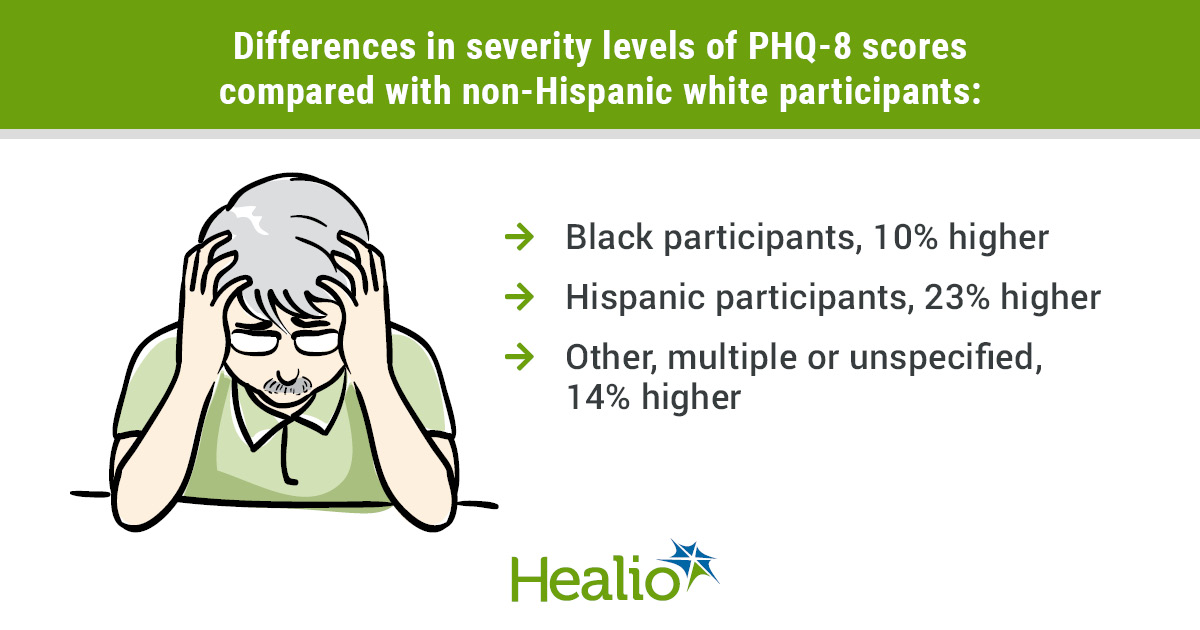Severity, features of late-life depression differ according to racial/ethnic group

Researchers observed significant racial and ethnic differences in late-life depression severity, item-level symptom burden and depression care among older adults after adjusting for numerous confounders, according to results of a cross-sectional study published in JAMA Network Open.
“Our findings were in line with prior reports of higher depression severity among minority older adults, although this study is one of the largest to date,” Olivia I. Okereke, MD, SM, of the department of psychiatry at Massachusetts General Hospital, told Healio Psychiatry. “However, it was particularly novel that we saw differences by racial/ethnic group in the specific features of depression. This is potentially important because it has implications for understanding health disparities. For example, if some groups are more likely to endorse certain symptoms or features of depression (ie, loss of interest and trouble concentrating) but not others (ie, feeling sad), then it is possible that their depression could go unrecognized or undertreated.”
Previous studies suggested that older adults who belong to racial or ethnic minority groups face disparities in both depression care and burden. Race/ethnicity can be viewed as a “complex multidimensional construct comprising heterogenous societal and cultural factors,” the researchers wrote. Thus, race/ethnicity may serve as a proxy for social determinants of health, in some contexts.
Okereke and colleagues aimed to examine racial/ethnic differences in depression severity, symptom burden and care. They analyzed 25,503 community-dwelling older adults (mean age, 67.1 years; standard deviation, 7.1 years) who participated in the Vitamin D and Omega-3 Trial (VITAL) — a randomized trial of cardiovascular disease and cancer prevention conducted from November 2011 to December 2017. Racial/ethnic group served as the exposure.

The researchers assessed depressive symptoms using the Patient Health Questionnaire-8 (PHQ-8) and depression using participant-reported diagnosis, medication and/or counseling. Further, they evaluated differences across racial/ethnic groups using multivariable zero-inflated negative binomial regression, and they compared these outcomes with PHQ-8 scores and multivariable logistic regression to estimate odds of item-level symptoms burden and depression treatment odds among individuals with diagnosed depression.
Of the older adults analyzed, 12,888 (50.5%) were women, 17,828 (69.9%) were non-Hispanic white, 5,004 (19.6%) were black, 1,001 (3.9%) were Hispanic, 377 (1.5%) were Asian and 1,293 (5.1%) were categorized in the other, multiple or unspecified race group.
The researchers adjusted for health, sociodemographic and lifestyle confounders and found the following differences in severity levels of PHQ-8 scores when racial/ethnic minority participants were compared with non-Hispanic white participants:
- black participants, 10% higher (rate ratio [RR] = 1.1; 95% CI, 1.04-1.17);
- Hispanic participants, 23% higher (RR = 1.23; 95% CI, 1.1-1.38); and
- other, multiple or unspecified, 14% higher (RR = 1.14; 95% CI, 1.04-1.25).
Participants belonging to minority groups had 1.5-fold to 2-fold significantly higher fully adjusted odds of anhedonia, sadness and psychomotor symptoms compared with non-Hispanic white participants. Multivariable-adjusted odds of guilt and sleep problems appeared higher among Hispanic vs. non-Hispanic white participants. Black participants with clinically significant depressive symptoms and/or diagnosed with depression were 61% less likely to report any treatment, such as counseling and/or medications, than non-Hispanic white participants after adjusting for confounders (adjusted OR = 0.39; 95% CI, 0.27-0.56).
“We were not surprised to confirm earlier findings of higher severity of depression among older minority adults,” Okereke told Healio Psychiatry. “However, the findings on the extent of variation by racial/ethnic group in the specific items or features of depression were notable and have not been reported elsewhere, as far as we know. Also, it was striking that we saw evidence of a large disparity in treatment for depression, even among those who reported high levels of symptoms and were diagnosed by clinicians as having depression. We need to do more to understand the reasons for this and to identify the range of factors that may underlie these findings.” – by Joe Gramigna
Disclosures: Okereke reports receiving grants from the NIH and book royalties from Springer Publishing. Please see the study for all other authors’ relevant financial disclosures.
